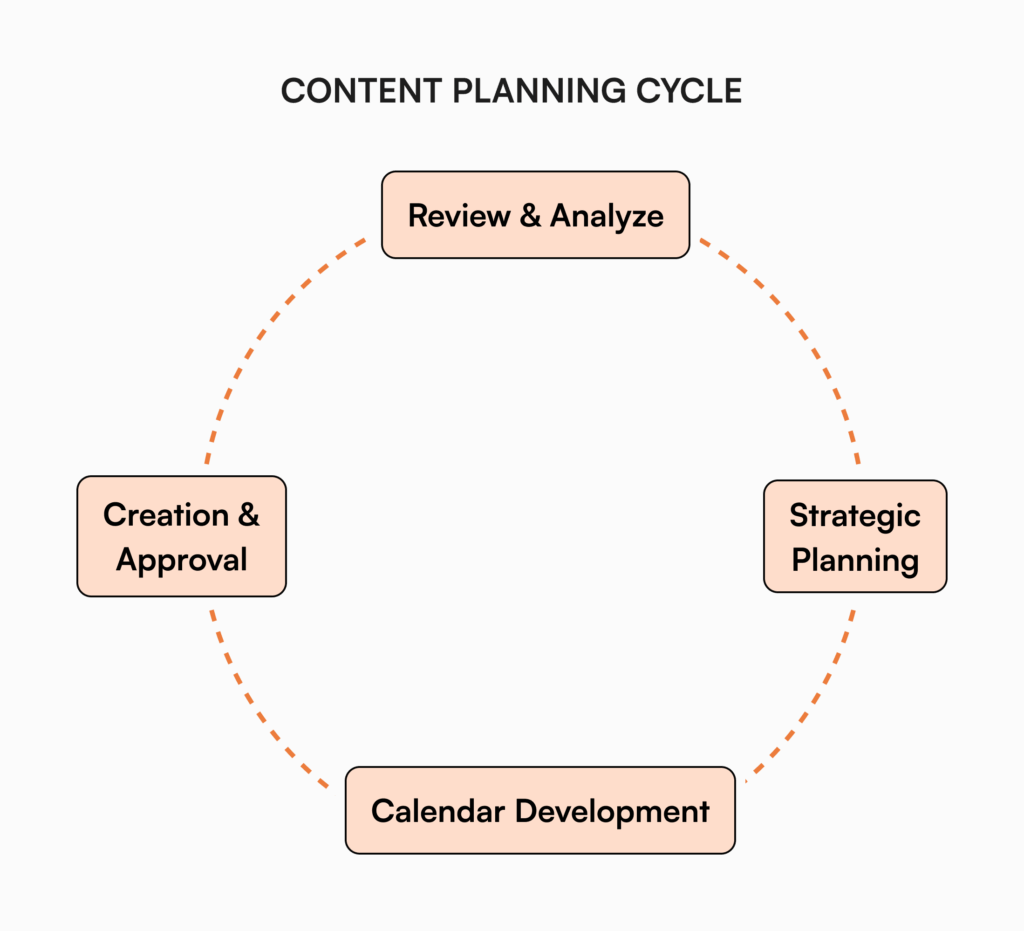You’ve built a skilled marketing team, but why are you still spending hours each quarter reinventing your content planning process? If your team is like most marketing departments, you’re sitting on a goldmine of institutional knowledge, previous campaign strategies, and content assets that could streamline your planning efforts, if only you could access them efficiently.
According to a Panopto study, employees spend an average of 5 hours every week waiting to get information from colleagues who have the knowledge they need. For marketing teams juggling multiple campaigns, channels, and deadlines, this inefficiency translates directly to missed opportunities and wasted resources. Your internal knowledge base should serve as the central repository for this critical marketing intelligence.
When your social media manager creates an exceptional Q1 campaign strategy document but three months later, nobody can find it to reference for Q2 planning, you’re not just losing time; you’re losing valuable insights that could inform future success. Your internal knowledge base should serve as the central repository for this critical marketing intelligence.
Common challenges in marketing content planning
If you’ve ever thought, “Didn’t we write this down somewhere?” while planning a new campaign, you’re experiencing one of the most common pain points in marketing knowledge management. The challenges typically fall into several categories:
Scattered documentation across multiple tools
Marketing teams often use a mix of project management tools, cloud storage, email, and chat platforms, creating a fragmented knowledge landscape. That campaign brief might be in Asana, while the performance metrics are in a Google Sheet, and the creative assets live in Dropbox.
Inconsistent templates and processes
When every team member follows their own process for documenting campaign strategies and results, finding and utilizing that information later becomes nearly impossible. Without standardized templates, valuable insights get buried in inconsistent formats.
Knowledge exodus when team members leave
When employees leave a company, they take a wealth of their knowledge with them. For marketing teams with high turnover, this creates a perpetual cycle of reinventing the wheel as institutional knowledge walks out the door.
Difficulty sharing insights across departments
Marketing doesn’t operate in isolation. You need input from sales, product, and customer success teams. However, when knowledge is siloed, cross-departmental collaboration suffers. Mitel’s Workplace Productivity report found that nearly 15% of employees’ work time is wasted because of inefficient communication.
Time wasted recreating existing plans
Perhaps the most frustrating challenge is recreating content plans that already exist somewhere in your organization. In one study of American workers, employees wasted nearly 6 hours per week duplicating others’ work due to knowledge management inefficiencies.

Building your marketing content planning system
Transforming your team’s approach to knowledge management requires more than just choosing a new tool. It demands a systematic approach to capturing, organizing, and leveraging your collective marketing wisdom.
Step 1: Audit your existing content and knowledge assets
Begin by taking inventory of what content and knowledge already exists within your organization:
- Campaign briefs and strategies from previous quarters
- Content calendars and publishing schedules
- Performance analytics and insights from past campaigns
- Creative briefs and brand messaging guidelines
- Customer research and persona documentation
- Competitive analysis and market research
This audit helps identify knowledge gaps, prevents duplication of efforts, and surfaces valuable resources that can inform your upcoming content planning.
Step 2: Create a centralized structure for marketing documentation
With your audit complete, establish a centralized internal knowledge base that serves as your single source of truth. This could take several forms:
- A dedicated knowledge management platform for organizing marketing resources
- A structured document repository with consistent naming conventions
- A collaborative workspace where team members can contribute and refine documentation
What matters most is that everyone knows where to find and store critical information. Your system should include categories for different types of content, such as campaign strategies, content calendars, brand guidelines, and performance analytics.
Step 3: Standardize your content planning templates and processes
Consistency is crucial for effective knowledge management. Create standardized templates for:
- Content calendars
- Campaign briefs
- Performance reporting
- Content creation workflows
- Approval processes
These templates ensure that information is captured consistently, making it easier to find and utilize later. They also streamline onboarding for new team members, who can plug into established processes rather than developing their own.
Step 4: Implement visibility and access controls for different stakeholders
Not everyone needs access to every piece of content. Implement granular permissions that provide:
- Read-only access for stakeholders who need information but shouldn’t modify it
- Edit access for team members actively working on specific campaigns
- Admin access for managers who oversee the entire content strategy
This approach maintains information security while ensuring that knowledge flows to those who need it most.
The quarterly content planning framework
With your knowledge management system in place, you can now leverage it to plan three months of marketing content efficiently.

Phase 1: Review and analyze previous performance (Week 1)
Begin by examining what worked and what didn’t in previous quarters:
- Pull performance metrics from your knowledge base for the past 2-3 quarters.
- Analyze content engagement patterns across channels.
- Review seasonal trends from previous years.
- Document key insights from customer feedback and social listening.
This historical data, now easily accessible through your knowledge management system, provides a foundation for data-driven planning.
Phase 2: Strategic planning and content mapping (Week 2)
Create your strategic framework for the quarter:
- Define key marketing objectives and KPIs.
- Identify content themes and pillars aligned with business goals.
- Map content needs to customer journey stages.
- Determine channel priorities based on previous performance.
Your standardized planning templates make this process significantly faster, as you’re not starting from scratch each quarter.
Phase 3: Content calendar development (Week 3)
With your strategy in place, develop your detailed content calendar:
- Plot major campaigns and content pieces across the quarter.
- Schedule recurring content series and regular posts.
- Allocate resources and assign responsibilities.
- Identify content repurposing opportunities to maximize efficiency.
Your knowledge base provides ready access to existing content that can be updated or repurposed, saving significant production time.
Phase 4: Content creation and approval workflows (Week 4+)
Streamline your content creation process:
- Use templates from your knowledge base for briefing creators.
- Reference brand guidelines and messaging frameworks for consistency.
- Follow standardized approval workflows to minimize bottlenecks.
- Document decisions and feedback for future reference.
Your knowledge management system ensures that everyone involved in content creation has access to the information they need, exactly when they need it.
Knowledge management best practices for marketing teams
To maximize the value of your knowledge management approach, implement these best practices:
Regular documentation updates
Schedule quarterly reviews of your knowledge base to update outdated information, archive irrelevant content, and ensure that all documentation remains current.
Cross-team visibility
Create opportunities for sales, product, and customer success teams to access and contribute to marketing knowledge, fostering collaboration and alignment.
Version tracking
Maintain clear version history for living documents like brand guidelines or campaign strategies, so team members can understand how and why approaches have evolved.
Approval workflows
Establish clear approval processes for knowledge base contributions, ensuring that information is accurate and valuable before being shared widely.
Search and tagging
Implement robust search functionality and consistent tagging practices to make information easily discoverable, even as your knowledge base grows.
Key takeaways
By establishing a systematic approach to marketing knowledge management, you can transform your content planning process from a recurring headache into a strategic advantage:
- Centralize marketing knowledge to eliminate time wasted searching for information.
- Standardize documentation to ensure consistency and easy access.
- Leverage historical data to inform future content decisions.
- Foster cross-team collaboration through shared knowledge.
- Preserve institutional wisdom even as team members change.
The result is not just more efficient planning but better content outcomes. When your team can build on past successes rather than starting from zero each quarter, they’re free to focus on innovation rather than recreation.
Why AllyMatter
AllyMatter provides marketing teams with a centralized internal knowledge base that transforms how they create, share, and leverage critical content planning information. With intuitive organization using smart tags and custom categories, teams can instantly find previous campaign strategies, content calendars, and performance metrics that would otherwise be lost in scattered systems.
Marketing departments particularly benefit from AllyMatter’s granular access controls, which allow for secure sharing with stakeholders across sales, product, and leadership teams. Version tracking ensures everyone works from the most current information, while the complete audit trail provides accountability for content approvals and campaign decisions.
For growing marketing teams facing increasing content demands, AllyMatter eliminates the chaos of scattered documentation and preserves institutional knowledge, allowing your team to build on past successes rather than repeatedly starting from scratch.
Ready to transform your marketing team’s content planning process? Join our waitlist.
Frequently asked questions
How much time can a marketing team save with a proper internal knowledge base?
Research shows that employees spend approximately 5 hours per week waiting for information from colleagues and another 8 hours trying to recreate existing information. For marketing teams juggling multiple campaigns and channels, implementing a proper internal knowledge base can reclaim these 13 hours weekly, nearly two full workdays per team member. Over a quarter, this translates to roughly 156 hours of recovered productivity per person that can be redirected toward strategic thinking and creative development rather than administrative searching.
What marketing documents should be included in our internal knowledge base?
Your internal knowledge base should include all documentation critical to marketing operations and institutional memory. Priority documents include campaign briefs and post-mortems, content calendars and editorial guidelines, brand standards and messaging frameworks, audience personas and research findings, performance metrics and analytics reports, and workflow processes and approval chains. By centralizing these assets, you create a self-service resource that reduces interruptions and ensures consistency across your marketing efforts.
How can we ensure our marketing team actually uses our knowledge management system?
Driving adoption requires both cultural and practical approaches. Start by involving team members in the system design process to ensure it addresses their actual pain points. Integrate the knowledge base with tools your team already uses daily, such as Slack or project management platforms, to reduce friction. Recognize and reward knowledge sharing behaviors through team meetings and performance reviews. Most importantly, lead by example. When leaders consistently document decisions and reference the knowledge base, it signals its importance to the entire team.
How long does it take to implement a marketing knowledge base system?
Most marketing teams can establish a functional knowledge base within 4-6 weeks. The first week involves auditing existing content, the second week focuses on creating standardized templates, and weeks 3-4 are spent on initial content migration and team training. However, building a comprehensive system that captures all institutional knowledge is an ongoing process that evolves with your team.
What’s the ROI of investing in marketing knowledge management?
For marketing teams, effective knowledge management translates to faster campaign planning, reduced content recreation, and more strategic time allocation. Teams typically see immediate benefits in reduced search time and improved campaign consistency within the first quarter of implementation.
How do we get marketing team members to actually contribute to our knowledge base?
Success depends on making contributions easy and valuable. Start by integrating the knowledge base into existing workflows rather than creating separate processes. Recognize contributors during team meetings and demonstrate how their documentation helps colleagues. Most importantly, lead by example – when managers consistently document decisions and reference the knowledge base, teams naturally follow suit.


